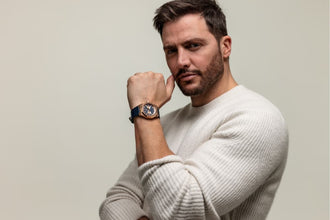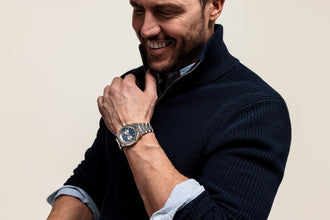

When it comes to your watch, size definitely matters. In order to find the correct sized watch, there are a few important things to consider.
With internet shopping proving to be extremely popular as years go on, companies have made it easier than ever when it comes to finding the right-sized watch.
We’ve broken down every important detail to consider before buying a watch.
Wrist Size
The initial stage of finding out what size watch you should buy is to measure your wrist accurately. You can do this by using a standard tailors tape.
The easiest method to use when you're trying to measure your wrist is to place the underside of your wrist face up, this will give you more control over the tape and make it easier to hold.
If you want to be as precise as possible, then opening your palm and spreading your hand out will widen your wrist and give an accurate measurement.
If you’re unsure how to use tailors tape, simply place the metal end in the centre of your wrist and wrap it around tightly until it fits snug. You should be able to see which measurement lines up either in centimetres or millimetres - this will be the size to look for when you buy a watch.
Is Your Wrist Small, Average or Large?
Once you’ve completed measuring your wrist, you’ll be able to determine whether your wrist size is small, average or large.
Everyone's wrists are different, so making sure you get the sizing right will help your watch look at its best. Knowing how big your wrist is will also help you when it comes to choosing which size case to go for.
Six-Inch Wrist
Considered small. A small to medium-sized diameter case that measures between 34mm to 38mm will fit best.
Seven-Inch Wrist
Considered average. Diameter cases ranging anywhere between 39mm, 40mm and 42mm should fit perfectly.
Eight-Inch and Larger
Considered large. Going for cases between 44mm up to 46mm will give help give a proportioned appearance.
Knowing these measurements will come in handy when it comes to buying a watch, especially if it’s your first time. Keeping note of any informative measurements will help when it comes to buying additional bands or watch accessories.
Finding the Right Sized Watch Case
A watch case is the part of a watch that contains the movement and dial. The thickness of a watch case plays an important role when it comes to finding the right-sized watch for your wrist.
The watch case is undoubtedly the most striking feature of a watch. It’s crucial that your watch case is the right size, not only is it what people will see first when they look down at your wrist but it's also where you'll be reading the time.
Standard Case Thickness
If you already own a watch and want to find out its case size, place a calliper device on each side of your watch and measure the distance.
This method is better than using tailors tape, as calliper devices can measure flat surfaces more accurately.
- 31mm and below is the thinnest case size in the industry.
- 32mm to 41mm is average and probably the most popular size to use.
- 42mm to 47mm is the thickest size a case can go, usually used on larger-faced watches.
How to Choose the Right Watch Strap
The act of changing your watch strap reflects individual style. People swap and change their watch straps all the time, but are you buying the right size?
The size of your watch strap should be a similar size to your watch face. Having a large watch face with a thin strap attached to it will create a disproportioned look - potentially ruining your watch's overall appearance.
Although it’s completely down to preference, we recommend sticking to the strap that comes with your watch. Watchmakers know all about sizing, so changing it to a smaller or larger size might not look right.
The smaller your wrist is, the smaller your watch is going to be, so pairing it with a wide strap could give your watch a larger appearance, which won’t look good.
Watch Lug
Watch lugs are attachments that are used to help secure a strap to the watch case. The distance between the two is also commonly known as the lug width - usually measured in millimetres.
It’s crucial to keep your watch’s lug width in mind when it comes to buying any additional straps. The lug width helps you get an estimate of how wide a replacement strap should be.
Which is The Correct Side to Wear a Watch On?
The main rule when it comes to wearing a watch is that it should always be worn on your non-dominant wrist, in most cases, this is the left.
So, if you’re left-handed, we recommend wearing your watch on your opposite wrist and vice versa. Most people choose their left hand regardless, as the crown faces outwards this way, allowing better accessibility.
Although this is a common rule to follow, don’t feel dictated to wear your watch a specific way if it’s not comfortable.
Luxury Amavi Watches
We’re proof that luxury, high-quality watches don’t have to come with an extortionate price tag. We have a full range of mens affordable watches to suit everyone’s style.
Our Collections
At Amavi, we have three main collections, Prestige, Ladies Amor and Urban.
A quintessential collection to match any style. Our most luxurious collection to date is our Prestige Collection, full of timeless pieces that have been beautifully crafted.
The definition of pure elegance and made with the finest materials and craftsmanship, our Ladies Amor collection was created for those wanting a watch with the finest appearance.
We’ve created the urban collection for those who have adopted a more simplistic look. This collection still has that luxurious feeling we care so much about at Amavi, as well as oozing style and sophistication.
We provide important product information with sizing and bandwidth stated clearly for each of our Amavi watches, making your online shopping experience easier than ever.






